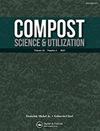葡萄果渣堆肥作为优质黄瓜苗圃基质的研究苗生产
IF 0.9
4区 农林科学
Q3 ECOLOGY
引用次数: 6
摘要
摘要通过温室试验,评价了葡萄果渣堆肥作为栽培基质对黄瓜发芽发育的影响。采用随机完全区组设计,采用13个处理(S1-S13),包括100%堆肥的GFW、60%GFW+40%家禽粪便(包括硬木木屑)、80%GFW+20%蚕豆秸秆、80%GFW+20%家禽肥料(包括小麦秸秆)、50%椰子泥炭+50%蛭石(作为对照)以及基于GFW的堆肥与椰子泥炭或蛭石的不同组合。结果表明,无论其来源如何,GFW与蚕豆秸秆和家禽粪便混合都能改善堆肥GFW的化学性能。GFW堆肥的营养成分,即N、P、K、有机质、可溶性阳离子和阴离子以及C/N比,甚至比对照(50%椰子泥炭+50%蛭石)更丰富,但pH和电导率(EC)较低。GFW堆肥中Cu、Fe、Cd和Pb的浓度显著低于对照基质;而总酚含量在GFW的单个堆肥中显著最高。将GFW堆肥与蛭石或椰子泥炭(体积比为1:1)混合对种子发芽和幼苗生长参数是最佳的;在大多数情况下,这些组合底物显示出最高的FGP、CGRI、存活率和生长参数。将GFW堆肥与椰子泥炭或蛭石混合可以消除或改善单一GFW堆肥的负面影响,因此将GFW肥料与椰子泥炭和蛭石基质按1:1的比例混合可以显著提高种子的发芽率、幼苗生长和存活率。这些回收的废物是低成本的产品,可以在商业规模的园艺苗圃中有效使用。亮点葡萄果渣堆肥与椰子泥炭和蛭石混合物具有相似的化学性质葡萄果渣肥料的总酚含量最高用GFW堆肥代替椰子泥炭或蛭石可以提高黄瓜的种子发芽率将GFW堆肥与椰子泥煤或蛭石混合可以改善黄瓜的幼苗发育用GFW代替椰子泥煤和蛭石堆肥使成本降低了50%本文章由计算机程序翻译,如有差异,请以英文原文为准。
Grape Fruit Waste Compost as a Nursery Substrate Ingredient for High-Quality Cucumber (Cucumis sativus L.) Seedlings Production
Abstract Greenhouse experiments were conducted to evaluate the utilization of compost derived from grape fruit waste (GFW) as an ingredient in nursery substrates for germination and development of cucumber. A randomized complete block design was used with thirteen treatments (S1-S13) encompassing 100% composted GFW, 60% GFW + 40% poultry manure including hardwood sawdust, 80% GFW + 20% broad bean straw, 80% GFW + 20% poultry manure including wheat straw, 50% coco peat + 50% vermiculite (as a control) and different combination of GFW-based composts with either coco peat or vermiculite. The resulted illustrated that GFW mixed with broad bean straw and poultry manure regardless of its source improved the chemical properties of composted GFW. Composts of GFW were even richer in nutrients, i.e., N, P, K, organic matter, soluble cations and anions and C/N ratio than control (50% coco peat + 50% vermiculite) except pH and electrical conductivity (EC), which was lower. Concentration of Cu, Fe, Cd and Pb were significantly lower in GFW composts than control substrate; while total phenolic content was significantly the highest in single compost of GFW. Mixing GFW composts with either vermiculite or coco peat (at 1:1 ratio by volume) was optimal for seed germination and seedling growth parameters; those combined substrates showed the highest FGP, CGRI, survival rate, and growth parameters in most cases. The negative effects of singly GFW compost can be removed or improved by mixing it with coco peat or vermiculite, so seed germination, seedling growth and survival rate significantly enhanced with mixing GFW-compost with coco peat or vermiculite substrates at ratio of 1:1. These recycled wastes are low cost products that can be usefully used in horticultural nurseries on a commercial scale. Highlights Grape fruit waste compost had similar chemical properties to coco peat and vermiculite mixture Grape fruit waste compost had the highest total phenolic content Replacing coco peat or vermiculite by GFW compost enhanced seed germination of cucumber Mixing GFW compost with either coco peat or vermiculite improved seedling development of cucumber Replacing coco peat or vermiculite by GFW compost reduced the cost by 50%
求助全文
通过发布文献求助,成功后即可免费获取论文全文。
去求助
来源期刊

Compost Science & Utilization
农林科学-生态学
CiteScore
4.10
自引率
0.00%
发文量
0
审稿时长
>36 weeks
期刊介绍:
4 issues per year
Compost Science & Utilization is currently abstracted/indexed in: CABI Agriculture & Environment Abstracts, CSA Biotechnology and Environmental Engineering Abstracts, EBSCOhost Abstracts, Elsevier Compendex and GEOBASE Abstracts, PubMed, ProQuest Science Abstracts, and Thomson Reuters Biological Abstracts and Science Citation Index
 求助内容:
求助内容: 应助结果提醒方式:
应助结果提醒方式:


